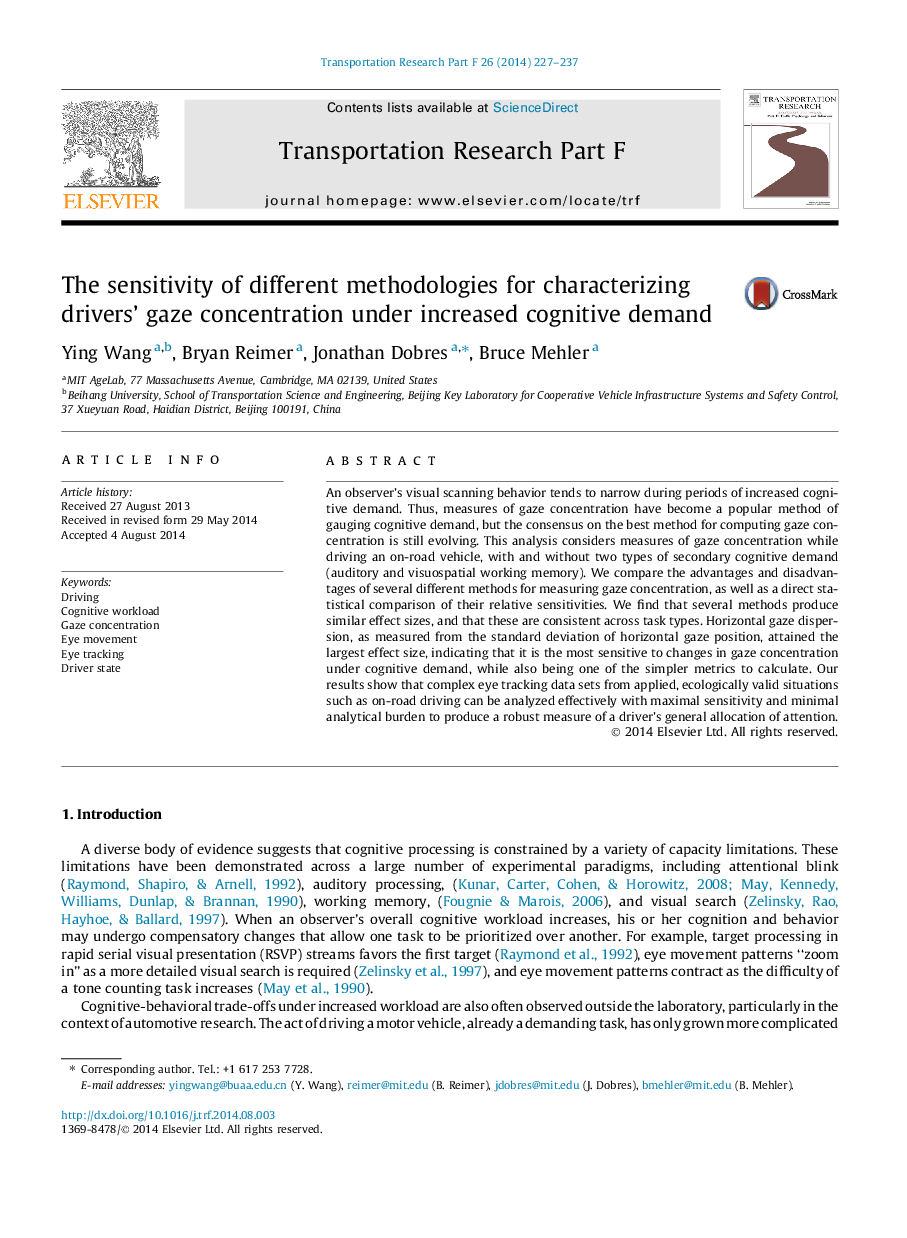| کد مقاله | کد نشریه | سال انتشار | مقاله انگلیسی | نسخه تمام متن |
|---|---|---|---|---|
| 10442970 | 915195 | 2014 | 11 صفحه PDF | دانلود رایگان |
عنوان انگلیسی مقاله ISI
The sensitivity of different methodologies for characterizing drivers' gaze concentration under increased cognitive demand
ترجمه فارسی عنوان
حساسیت روش های مختلف برای توصیف غلظت گاز در رانندگان با توجه به افزایش تقاضای شناختی
دانلود مقاله + سفارش ترجمه
دانلود مقاله ISI انگلیسی
رایگان برای ایرانیان
کلمات کلیدی
رانندگی، حجم کار شناختی، غلظت غده، جنبش چشم، ردیابی چشم، راننده دولت،
ترجمه چکیده
رفتار اسکن بصری ناظر در طول دوره های افزایش تقاضای شناختی تمایل دارد. بنابراین، اندازه گیری غلظت گاز، تبدیل به یک روش محبوب برای اندازه گیری تقاضای شناختی شده است، اما اجماع بر بهترین روش برای محاسبه تمرکز گاز هنوز در حال تکامل است. این تجزیه و تحلیل اندازه گیری غلظت گاز در هنگام رانندگی یک وسیله نقلیه جاده ای با و بدون دو نوع تقاضای شناختی ثانویه (حافظه شنوایی و حافظه کاری فضایی) را در نظر می گیرد. ما مزایا و معایب روش های مختلفی برای اندازه گیری غلظت گاز، و همچنین مقایسه آماری مستقیم حساسیت های آنها را مقایسه می کنیم. ما متوجه می شویم که روش های متعددی اندازه های مشابهی تولید می کنند و این در انواع کارها سازگار است. پراکندگی چشم افقی، که از انحراف استاندارد موقعیت چشم افقی اندازه گرفته شده، بزرگترین اندازه اثر را به دست آورد، که نشان می دهد که آن بیشتر حساس به تغییرات غلظت چشم در تقاضای شناختی است و همچنین یکی از معیارهای ساده برای محاسبه است. نتایج ما نشان می دهد که مجموعه داده های ردیابی پیچیده ای از موقعیت های کاربردی و محیط زیست معتبر مانند رانندگی در جاده ها می تواند به طور موثر با حساسیت حداکثر و حداقل تحلیلی بار برای تولید یک اندازه گیری قوی از تخصیص توجه راننده.
موضوعات مرتبط
علوم انسانی و اجتماعی
روانشناسی
روان شناسی کاربردی
چکیده انگلیسی
An observer's visual scanning behavior tends to narrow during periods of increased cognitive demand. Thus, measures of gaze concentration have become a popular method of gauging cognitive demand, but the consensus on the best method for computing gaze concentration is still evolving. This analysis considers measures of gaze concentration while driving an on-road vehicle, with and without two types of secondary cognitive demand (auditory and visuospatial working memory). We compare the advantages and disadvantages of several different methods for measuring gaze concentration, as well as a direct statistical comparison of their relative sensitivities. We find that several methods produce similar effect sizes, and that these are consistent across task types. Horizontal gaze dispersion, as measured from the standard deviation of horizontal gaze position, attained the largest effect size, indicating that it is the most sensitive to changes in gaze concentration under cognitive demand, while also being one of the simpler metrics to calculate. Our results show that complex eye tracking data sets from applied, ecologically valid situations such as on-road driving can be analyzed effectively with maximal sensitivity and minimal analytical burden to produce a robust measure of a driver's general allocation of attention.
ناشر
Database: Elsevier - ScienceDirect (ساینس دایرکت)
Journal: Transportation Research Part F: Traffic Psychology and Behaviour - Volume 26, Part A, September 2014, Pages 227-237
Journal: Transportation Research Part F: Traffic Psychology and Behaviour - Volume 26, Part A, September 2014, Pages 227-237
نویسندگان
Ying Wang, Bryan Reimer, Jonathan Dobres, Bruce Mehler,
